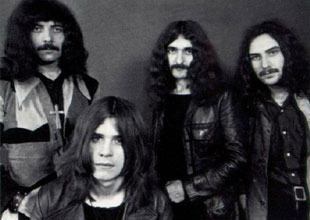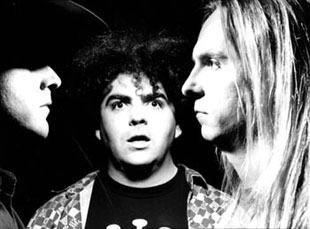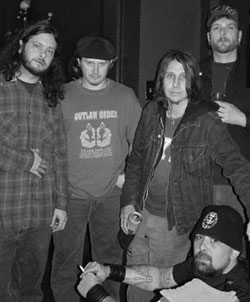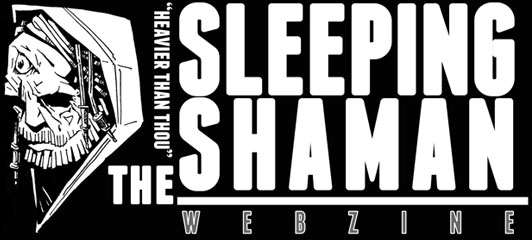Roots Of Sludge
Sludge is a thick mud or sediment, greasy, foul and noxious. Sounds good already. But when it comes to music, what the fuck do we mean by sludge? Like any label (and indeed it is a label, just like ‘grindcore’ or ‘industrial’), this one is used by the lazy individual, just like myself, to try to generalise a sound that is particular to a type of rock music. Broadly speaking, as you all bloody well know, sludge is characterised by a very slow tempo and a down tuned heaviness of guitar, lending the overall sound a thick sludge-like quality. Stick that one in yer dictionary, fascist lexiconographer. One feels one is actually wading through mud, and slowly sinking, like the sensation of being trapped in a dream, or being impossibly stoned on a red hot summers day, when one is listening to some piece of snail paced sonic genius like ‘Bull’ (‘Sixteen Tons’, 2003) by Weedeater or ‘Life Can Be..’ (‘Torso’, 1998) by Grief.

The earliest roots of sludge can be traced back to various non-musical sources; man’s primal awe-struck fascination with the power and movement of gigantic land animals like mammoths and giant sloths. Such behemoths had mesmerising and talismanic properties, and sludge metal is the modern sound of these beasts, a genre dedicated to an enormous pre-historic sloth, fucked out of its heavy skull from stupidly feasting on magic mushrooms like the three ton idiot glutton it is. Sludge as a genre differs from its equally sluggish siblings doom metal (usually slow, heavy, use of tri-tones and grim pseudo-gothic imagery) and stoner rock (slow-ish, often heavy, psychedelic and druggy). In a sense both those genres are older and more established, having influential forebears in the shape of Sabbath and the Stooges respectively.
Obviously the spiritual forefathers of the turgid musical form we call sludge were the fabled metal deities, Black Sabbath, who are often quite rightly credited as the primary influence, both musically and stylistically, behind much of the new heavy metal (as opposed to heavy rock) sound that was to follow Sabbath into the seventies. Sabbath formed in metal epi-centre Birmingham in 1968 as a heavy blues band and proceeded to burn a trail of truly beautiful proto-sludge riffs throughout the late sixties and into the heady seventies. Before Sabbath became dried out and jaded with uncut cocaine and life on the eternal tour bus with a dwarf, they wrote six albums of such utter depressive genius and pure metal power that we shall rightly worship them until we return back to the soil. Songs like the immortal classic ‘Sweet Leaf’ (‘Master of Reality’, 1971) laid down the blueprint for a whole generation of thick, distorted and super-heavy stoner rock that extolled the virtues of psychoactive escapism. Sabbath kick started the whole genre of doom metal with their use of diabolical tri-tones (musical intervals banned by the Catholic Church in the Middle Ages for being just too evocative of Lucifer) and dark gothic imagery (graveyards, crosses, church towers, chip shops). Just check out the (un)holy trinity of doom: Saint Vitus (formed 1979), God botherers Trouble (also formed 1979) and Candlemass (formed 1984) for proof of Sabbath’s legacy a decade later. Many contemporary sludgesters own at least summat by these three bands – proof that doom metal is a gene that is strongly prevalent in the roots of the slow-growing, foul stinking and immensely heavy sludge plant.

Sabbath also kind of half-spawned the sub-genre of stoner rock (listen to the narcoleptic fug of ‘Planet Caravan’ on ‘Paranoid’, 1970), along with fuzzed out wah wah primitive drug droners the Stooges (such an important outfit to the evolution of metal and punk, that their moniker shall forever be scrawled in virgin’s blood on the walls of the inner sanctum of the High Temple of Azathoth, the Blind Idiot Daemon Sultan of Eternal Destruction). I don’t really need to wax lyrical about the impact of Sabbath, that’s been done by a thousand dead journalists, and you all fucking realise that Sabbath alone represent the stoned and swollen earth mother of all that is truly heavy. Amen.
Whilst doomsters such as the aforementioned Saint Vitus etc. (also include here the masterful Pentagram, who’d been shuffling around in Sabbath’s shadow since the early seventies) were getting it on with their Orange and Sunn valve amps in the late seventies, the fractured punk scene in the UK had started to throw up some very interesting sounds in the form of the seminal Amebix (their 1985 album ‘Arise!’ is a hoary proto-crust masterpiece of unwashed underpants and dark west country schizophrenic menace), Antisect, and later in the eighties, crusty dreadlocked punk metallers like Deviated Instinct, Hellbastard, Axegrinder and the ever entertaining ‘punker than thou’ misfits Extreme Noise Terror, and later, the ultimate miserycore masters and true inheritors of the simple and brutal ethos of Discharge, Birmingham’s mighty Doom. All of these crusty fuckers were spawned by the vegan squatting animal liberating dominated anarcho-punk scene. Common amongst these bands was a love of Sabbath’s down-tuned riffageddon (and a fondness for Motorhead’s gnarled metal gunk) and a punk sensibility informed politically by the black-clad pseudo-hippy co-operative anarchism of Crass but musically (and politically too) by the gruff pessimism and sheer chainsawing power of Stoke’s Discharge. Listen to the incredible ‘Hear Nothing, See Nothing, Say Nothing’ (1982). The furious and bleak attitude and sound of so many later bands was born of Discharge and their blistering and genuinely ground breaking assault. They are the sonic fathers of fellow clayheads, Charger, who are like Discharge’s giant fat super-slow spoilt son, sick with bong-induced room spin, unable to even crawl off their filthy old sofa.

Now a quick step forward to the mid eighties and to the emerging excitement of thrash metal. Ah, ‘Mega-Metal Kerrang!’, shit baseball boots, Italian combat jackets with band names painted on the back, and gig audiences entirely composed of sexually inadequate bare-chested men. I myself was caught up in this whirlwind of riffs and skulls as a skinny wank-addicted teenager. Bands like Metallica (timeless early stuff obviously, not their later pompous exercises in rock banality), the genuinely progressive and unique Voivod (formed in 1982), most crucially Hellhammer (also formed 1982) – later to become mega-heavy death grunting Celtic Frost, and a little later still, skull rupturing good ol’ boys Pantera, were absolutely essential to what we call sludge today. About the same time Newcastle’s comical black magic headbangers Venom (who had been around since the very late seventies) and the only slightly less comical Bathory (founded in 1983 by the eccentric Quorthon) from Sweden were beginning to shape the Black Metal sound that also became quite influential to sludge. The hateful and undeniably primal power of black metal represents an extremism that is attractive to many practitioners and appreciators of sludge, regardless of whether they romp through ancient pine forests dressed as Nazi Vikings or not.
A year or two later and we turn our attention to the burgeoning Seattle/Washington scene. The Melvins (formed as a hardcore three piece in the early eighties) were a seminal outfit in the evolution of the sludge sound, themselves influenced by Black Flag, the legendary California hardcore band, who blended what Sabbath did with the emerging energy of hardcore. Just listen to the Melvin’s debut album ‘Gluey Porch Treatments’ (1987), true proto-sludge, years ahead of its time. No one else was playing it so slow and heavy at the time. The Melvins have created their own wonderful cult universe of bizarre art-sludge, carving out a twenty year plus career playing music on their own terms; one of those bands that exact a fanatical following of stoned semi-virginal nerds well into their thirties. The aforementioned Black Flag are the true missing link between Sabbath and punk and without their existence absolutely none of this would be possible. Tracks like ‘Life Of Pain’ (Damaged, 1981) frame not only the musical outline of later heaviness but also inject much of the stylistic concerns of this music; the preoccupation with stark misanthropy, self loathing, abuse, sexual frustration and depression; key themes for the zero generation of post sixties America.

Sludge therefore has its roots in both the lead heavy slowness of Sabbath-style doom metal and the anarchic aggression of punk, in particular US hardcore, and in particular the influence of maybe the first true sludge band, an ensemble that oozed directly out of Black Flag’s black hole of pain: New Orlean’s Eyehategod. These genius fuck ups developed their sludge sound in the early nineties and distilled the essence of Sabbath, Melvins, and most importantly, the ferocious strung out riffs of Black Flag’s Greg Ginn, in order to create a new down-tempo type of hardcore that was sodden in dope-driven self hatred. Much of the grunting and screaming vocals of contemporary sludge is influenced by the politicised rage of hardcore, not metal – which usually had its greasy banging head too far up its own scrawny arse to get angry over ‘issues’ and ‘the right’. Eyehategod seem to epitomise the contemporary sound of sludge far more closely than the Melvins, who always had a more laid back and experimental vibe. Mike Williams was the real life ‘fucked up on hard drugs’ Henry Rollins of sludge, his tortured vocals equalled dirty American nihilism, futility, a life of ruined events and of dark spiralling depression. The riffs were super slowed down sicko swamp blues, drenched in feedback, and of course any student of down-tempo can see a line here to the wheezing dope-sludge of Bongzilla and the sublime and psychotic Weedeater. No band has more successfully appropriated the musical equivalent of feeling so completely tripped out on weed than the Southern fried Weedeater, whose growling gurning bass wizard ‘Dixie’ Collins (founder of the influential sludge outfit Buzzoven) epitomises the true free spirit of stoner sludge, a real inspiration to us all. Pack in your day job, suck on that bong, strap on your down tuned bass, and rasp and slobber your blackened lungs out in grimy little venues all over the world. Fuck all the pretenders – Weedeater are the essence of rock ‘n’ roll.
Following the influence of the immediately impressive power of Eyehategod, the frenzied and much missed Iron Monkey came screaming out of Nottingham in 1994 like a big shit splattered juggernaut. Their two highly collectable albums are monolithic slabs of quality hate-sludge, the remarkable vocals of the late Johnny Morrow rip out the speakers like malicious ectoplasm. A little later in the nineties, in the wake of the Monkey– the ever reliable stalwarts of this putrid hell scene, Charger, came blasting out of the Potteries (a particularly fertile area involved in the harvesting of doom and sludge) in 1998 with their first raw ep, ‘Haul Ass’. It is also always worth mentioning the influence of Electric Wizard (Oborn is an incomparable uber-riff writer), and Orange Goblin. Both are, broadly speaking, stoner doom rock outfits but still they form some of the deformed roots of sludge – they’ve been around a long time and they both churn out some stinkingly heavy riffs. Just like Corby’s Raging Speedhorn, another very fine homegrown treasure, who have been influential to today’s ear drum brutalists in more ways than one; check the ferociousness of the insane twin vocals and riffs, and the power and sheer tone of the guitars.

Other important bands came through in this pre-millennial period, like the demented Khanate, the often overlooked Grief (founded in 1991), the Deep South’s Crowbar (formed in the early nineties) and The Obsessed (who were actually formed by the legendary Wino in the early eighties). Earth, the Seattle based band initially signed to Sub-Pop in the early nineties, were also an important catalyst in the sludge evolution, as were the inheritors of Earth’s drone doom ambience, Sunn0))). Stephen O’Malley, guitarist of Sunn0))), ex-Khanate, and co-founder (with the equally pivotal Sunn0)))/Goatsnake guitarist Greg Anderson) of the indispensable and innovative experimental doom label, Southern Lord, was also was a member, along with Anderson, of the influential sludge band Burning Witch. These super slow sonic dirge mongers, who formed in 1996, can still be seen on the t-shirts of sludge lovers across the world, and their one album (actually two ep’s), ‘Crippled Lucifer’ (1998), is a sludge landmark. O’Malley is one of several individuals, just like Jimmy Bower (guitarist founder of Eyehategod/ drummer of Down/ (ex)member of other bands) and maverick veteran sludge producer Billy Anderson (member of Porn/one time Melvins bassist, involved in numerous other projects too), who have been of crucial importance in the evolution of the slow and heavy sound. Such people are veritable Lords of Sludge, Magi of the Terminally Slow and Corruptingly Heavy, and their artistic input has fed directly into sludge-evolution.
Growing out of the anarcho-crust scene in the UK in the mid to late eighties superfast grindcore kings Napalm Death and slow industrial sub-metallers Godflesh were just two important bands, among many, that were signed to independent labels like Earache, Peaceville and Manic Ears, and both have helped to spawn the sludge sound, particularly in the UK. Slow Napalm Death down to a ponderous mammoth tempo, and you would hear a twenty first century sludge outfit. Their ‘Scum’ (1987) debut album, although far removed from sludge in terms of speed, but not in terms of style, has had an immeasurable impact upon this behemothic music of which I speak.

Neurosis (formed in 1985 as a metal-edged hardcore band) were another key band in the history of sludge. They blend metallic sludge, hardcore, sometimes folk and sometimes a nauseous industrial psychedelia in a potent and often menacing broth of personal and political anguish. They were partly influenced by the sound of UK crust, in particular Amebix (also a big influence on Japanese doom trio Gallhammer), and also, just like Godflesh, by the deafening power of early Swans, a New York based pre-post rock band whose harrowingly loud, slow and nihilistic early stuff profoundly inspired many notable ‘alternative’ rock bands (I hate that bloody term).
The thick and oppressive sound of sludge evokes feelings of alienation from a greedy ultra-violent world of confusion seemingly gone mad and the dislocated and schizoid feeling of being strung out on booze, downers and dope, an effectively temporary attempt at escape, and a traditional refuge of the metal head of the seventies. The super slow tempo and agonising chord changes of the leaden riffs (so heavy they threaten to collapse in on themselves like black holes) perfectly link to the double barrelled shotgun of depressant use/escape into heavy metal fantasy and political apathy via frustration. Such is this beast we call sludge, it crawls through the shit of life on its ruptured belly, eternally stoned, too heavy to escape its own ever increasing despair…always sinking further into the filth of human misery. And the crushing sounds that rip forth from its putrid gash of a gob are sweet ambrosia to elitist miscreants like you and me, brought up with rock and punk and metal and experimental noise, always searching for that perfect riff, forever lost in a smoke-filled Valhalla of guitar feedback, pounding drums and guttural screams. There is a power and freakish extremity to the bestest and heaviest sludge, particularly live in a sweaty run down pub at maximum ear fucking volume, that is like a big addictive narcotic drug.

By no means is this article conclusive or definitive, there will be various bastard things that are missing. It’s just my attempt to piece together a sort of genealogy of very slow very heavy rock music, using some semblance of chronology (that’s why I’ve somewhat annoyingly stuck in time line references – I’m a fuckin’ sludge geek). Some of the influential bands mentioned here are included not because they are slow, because some, like Napalm Death, are the exact opposite, but because of their style, attitude and the nature of their lyrical concerns and the extreme harshness of their vocals. All the artistes are united by one crucial factor; their sheer cerebral imploding heaviness. Feel free to contribute…and remember, in the immortal words of the Beastie Boys; “let it flow…let yourself go…slow and low…that is the tempo”.
Scribed by: Adam Stone

